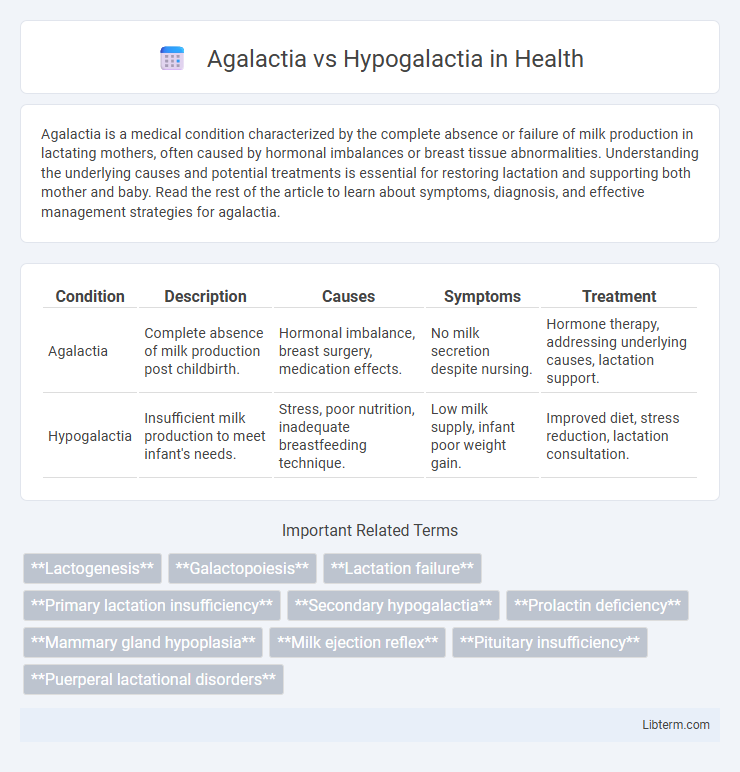Agalactia is a medical condition characterized by the complete absence or failure of milk production in lactating mothers, often caused by hormonal imbalances or breast tissue abnormalities. Understanding the underlying causes and potential treatments is essential for restoring lactation and supporting both mother and baby. Read the rest of the article to learn about symptoms, diagnosis, and effective management strategies for agalactia.
Table of Comparison
| Condition | Description | Causes | Symptoms | Treatment |
|---|---|---|---|---|
| Agalactia | Complete absence of milk production post childbirth. | Hormonal imbalance, breast surgery, medication effects. | No milk secretion despite nursing. | Hormone therapy, addressing underlying causes, lactation support. |
| Hypogalactia | Insufficient milk production to meet infant's needs. | Stress, poor nutrition, inadequate breastfeeding technique. | Low milk supply, infant poor weight gain. | Improved diet, stress reduction, lactation consultation. |
Understanding Agalactia and Hypogalactia
Agalactia refers to the complete absence of milk production postpartum, often caused by hormonal imbalances or breast tissue damage, whereas hypogalactia denotes insufficient milk supply despite ongoing lactation. Understanding the distinct etiologies and clinical presentations of agalactia and hypogalactia is critical for effective management and targeted interventions in lactation failure. Early diagnosis supported by hormonal assays and breast imaging can differentiate between these conditions, guiding appropriate therapeutic strategies to support maternal and infant nutrition.
Definitions: Agalactia vs. Hypogalactia
Agalactia is the complete absence of milk production, whereas hypogalactia refers to a reduced or insufficient milk supply during lactation. Agalactia indicates a total failure of lactation often due to physiological or pathological causes, while hypogalactia involves partial lactation with suboptimal milk output. Understanding the distinction between agalactia and hypogalactia is crucial for diagnosing and managing lactation disorders effectively.
Causes of Agalactia
Agalactia, characterized by a complete absence of milk production, often results from factors such as hormonal imbalances including prolactin deficiency, severe maternal stress, or previous breast surgery impacting mammary gland function. In contrast, hypogalactia refers to reduced milk supply rather than a total lack, frequently caused by insufficient breastfeeding stimulation, maternal malnutrition, or certain medications. Understanding these distinct etiologies is critical for targeted interventions to support lactation in affected mothers.
Causes of Hypogalactia
Hypogalactia is primarily caused by insufficient milk production due to hormonal imbalances, such as low prolactin levels, or physical issues like insufficient glandular tissue in the breasts. Additional causes include maternal factors like stress, poor nutrition, certain medications, and inadequate breastfeeding techniques, which can all impair milk supply. Unlike agalactia, where milk production is completely absent often due to pituitary gland failure or breast surgery, hypogalactia represents reduced milk output despite ongoing lactation efforts.
Key Differences Between Agalactia and Hypogalactia
Agalactia refers to the complete absence of milk production, whereas hypogalactia denotes a reduced milk supply despite the presence of some milk secretion. Key differences include the underlying causes: agalactia often results from hormonal imbalances or anatomical issues, while hypogalactia is commonly linked to insufficient gland stimulation or maternal health factors. Diagnostic criteria rely on milk output measurement, with agalactia showing zero production and hypogalactia showing quantitatively insufficient lactation.
Clinical Signs and Symptoms
Agalactia is characterized by the complete absence of milk production, leading to failure in lactation despite normal mammary gland development, while hypogalactia presents as reduced milk secretion with insufficient volume to meet infant nutritional needs. Clinical signs of agalactia include dry breasts, absence of milk expression, and frequent infant hunger cues due to insufficient feeding. In hypogalactia, symptoms manifest as weak infant sucking, prolonged feeding times, and signs of inadequate weight gain caused by decreased milk supply.
Diagnostic Approaches
Diagnostic approaches for agalactia primarily involve assessing complete lactation failure through clinical evaluation and hormonal profiling, including prolactin and oxytocin levels. In hypogalactia, diagnosis focuses on quantifying reduced milk production via milk output measurements and identifying underlying causes such as insufficient glandular tissue or metabolic disorders. Imaging techniques like ultrasound aid in differentiating structural abnormalities contributing to both agalactia and hypogalactia.
Management and Treatment Options
Management of agalactia, characterized by the complete absence of milk production, often requires addressing underlying causes such as hormonal imbalances or structural abnormalities through hormone replacement therapy or surgical intervention. Hypogalactia, involving insufficient milk supply, is commonly managed with galactagogues like domperidone and optimizing breastfeeding techniques to stimulate milk production. Both conditions benefit from lactation consultant support, nutritional optimization, and stress reduction to enhance overall breastfeeding outcomes.
Preventive Strategies
Preventive strategies for agalactia focus on ensuring adequate prolactin levels through proper maternal nutrition and stress management, while hypogalactia prevention emphasizes optimizing breastfeeding techniques and regular milk removal to maintain supply. Monitoring maternal health for hormonal imbalances and early lactation support can reduce the risk of both conditions. Implementing prenatal education on breastfeeding and timely medical consultations helps improve lactation outcomes effectively.
Prognosis and Outcomes
Agalactia, the complete absence of milk production, typically results in poor neonatal nutrition outcomes without immediate medical intervention or hormone therapy, often requiring supplemental feeding strategies. Hypogalactia, characterized by insufficient milk volume, presents a more favorable prognosis as partial breastfeeding can be maintained alongside lactation support measures, improving infant weight gain and immunological benefits. Early diagnosis and tailored treatment significantly enhance long-term breastfeeding success and infant health in both conditions.
Agalactia Infographic

 libterm.com
libterm.com